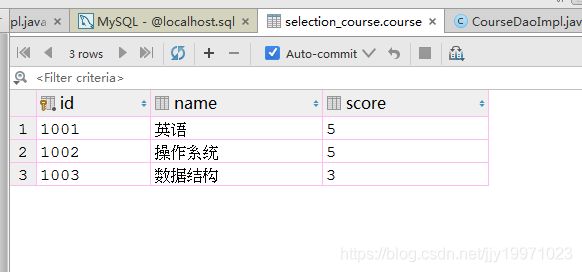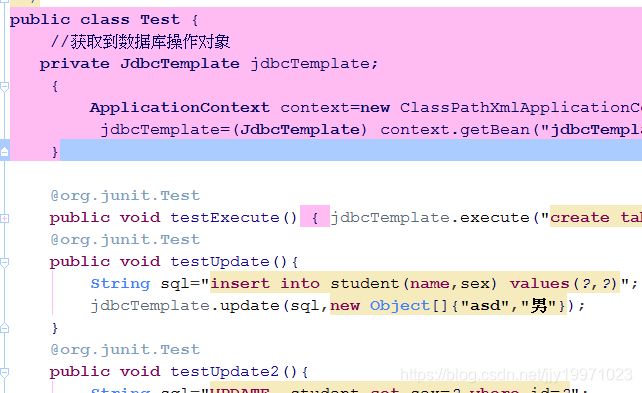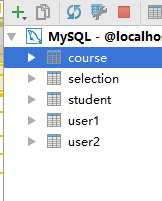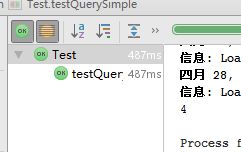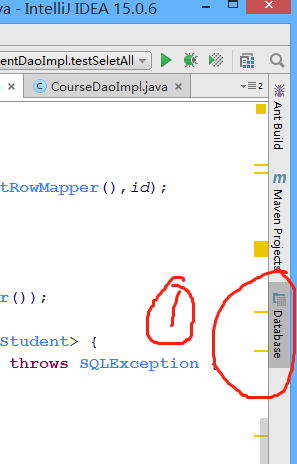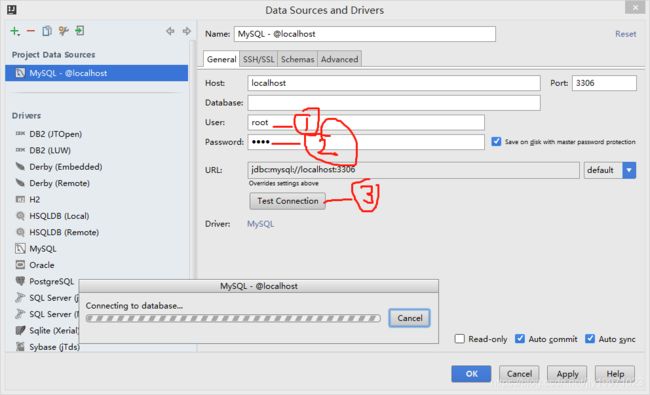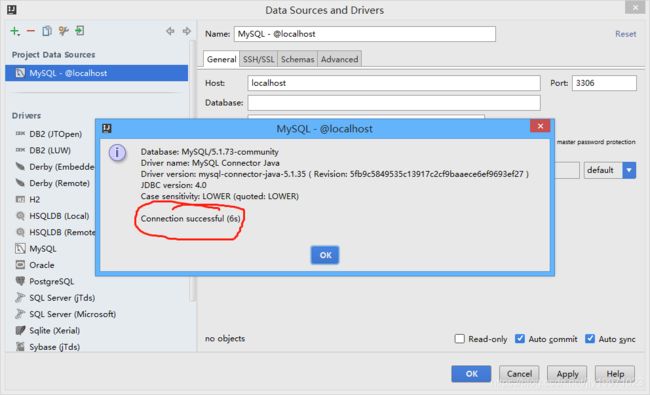Spring菜鸟小白学习笔记---此节图片特多,逐步讲解Spring jdbcTemplate&&&&idea环境下配置项目数据库
上一次我们说到了Spring的AOP
总体目录在此
本节来说下:
Spring JDBC Template
代码–》JDBC API–》JDBC驱动–》数据库
代码–》JDBC Template—》JDBC API–》JDBC驱动–》数据库
JDBC Template提供统一的模板方法,在保留代码灵活性的基础上,尽量减少持久化代码
JDBC Template基本使用
execute方法执行DDL(数据定义语言:定义表名,标题,列名,及其结构)语句
update与batchUpdate方法更新方法
update 对数据进行增删改操作
batchUpdate批量增删改
query和queryXXX方法查询方法
查询简单数据项
获取一个数据
获取多个数据
获取复杂对象(封装为Map)
查询复杂对象RowMapper接口
call方法调用存储过程
优点:
简单
灵活
缺点:
Java代码和SQL代码掺杂
功能不丰富
对于如何在idea环境下配置数据源的详细步骤,idea的内置功能很方便我们查看和配置我们的数据库,此部分在文章末尾,请直接下滑
为了逐个实现JDBCTemplate我们首先创建测试用数据库
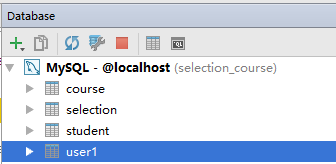
代码如下
drop database if exists selection_course;
create database selection_course;
use selection_course;
create table course
(
id int not null auto_increment,
name char(20),
score int,
primary key (id)
);
create table selection
(
student int not null,
course int not null,
selection_time datetime,
score int,
primary key (student, course)
);
create table student
(
id int not null auto_increment,
name varchar(20),
sex char(2),
born date,
primary key (id)
);
alter table selection add constraint FK_Reference_1 foreign key (course)
references course (id) on delete restrict on update restrict;
alter table selection add constraint FK_Reference_2 foreign key (student)
references student (id) on delete restrict on update restrict;
insert into course(id,name,score) values(1001,'英语',5);
insert into course(id,name,score) values(1002,'操作系统',5);
insert into course(id,name,score) values(1003,'数据结构',3);
commit;
链接
创建好之后我们的项目结构如下

创建好对应的包,然后我们修改下pom文件来引入我们项目所需要的依赖
<?xml version="1.0" encoding="UTF-8"?>
<project xmlns="http://maven.apache.org/POM/4.0.0"
xmlns:xsi="http://www.w3.org/2001/XMLSchema-instance"
xsi:schemaLocation="http://maven.apache.org/POM/4.0.0 http://maven.apache.org/xsd/maven-4.0.0.xsd">
<modelVersion>4.0.0</modelVersion>
<groupId>com.jjyu</groupId>
<artifactId>sc</artifactId>
<version>1.0-SNAPSHOT</version>
<properties><spring.version>4.0.2.RELEASE</spring.version>
</properties>
<dependencies>
<dependency>
<groupId>mysql</groupId>
<artifactId>mysql-connector-java</artifactId>
<version>5.1.47</version>
</dependency>
<dependency>
<groupId>org.springframework</groupId>
<artifactId>spring-core</artifactId>
<version>${spring.version}</version>
</dependency>
<dependency>
<groupId>org.springframework</groupId>
<artifactId>spring-beans</artifactId>
<version>${spring.version}</version>
</dependency>
<dependency>
<groupId>org.springframework</groupId>
<artifactId>spring-context</artifactId>
<version>${spring.version}</version>
</dependency>
<dependency>
<groupId>org.springframework</groupId>
<artifactId>spring-aop</artifactId>
<version>${spring.version}</version>
</dependency>
<dependency>
<groupId>org.springframework</groupId>
<artifactId>spring-jdbc</artifactId>
<version>${spring.version}</version>
</dependency>
<dependency>
<groupId>org.springframework</groupId>
<artifactId>spring-tx</artifactId>
<version>${spring.version}</version>
</dependency>
<dependency>
<groupId>junit</groupId>
<artifactId>junit</artifactId>
<version>4.12</version>
</dependency>
</dependencies>
</project>
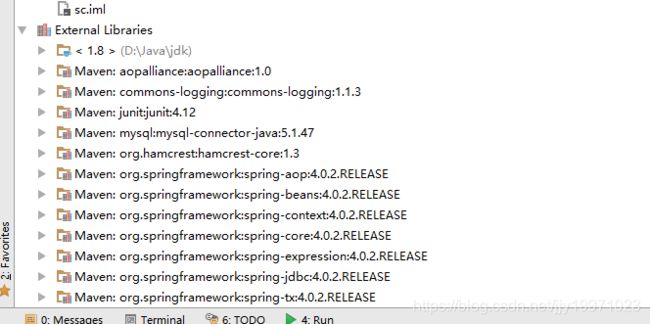
一共这些,你引入对了吗?
接下来为了操作数据库我们要在entity包中创建与数据库对应的实体类
三个实体类如下所示

public class Course {
private int id;
private String name;
private int score;
public int getId() {
return id;
}
public void setId(int id) {
this.id = id;
}
public String getName() {
return name;
}
public void setName(String name) {
this.name = name;
}
public int getScore() {
return score;
}
public void setScore(int score) {
this.score = score;
}
}
public class Selection {
private int sid;
private int cid;
private Date selTime;
private int score;
public int getSid() {
return sid;
}
public void setSid(int sid) {
this.sid = sid;
}
public int getCid() {
return cid;
}
public void setCid(int cid) {
this.cid = cid;
}
public Date getSelTime() {
return selTime;
}
public void setSelTime(Date selTime) {
this.selTime = selTime;
}
public int getScore() {
return score;
}
public void setScore(int score) {
this.score = score;
}
}
public class Student {
private int id;
private String name;
private String sex;
private Date born;
public int getId() {
return id;
}
public void setId(int id) {
this.id = id;
}
public String getName() {
return name;
}
public void setName(String name) {
this.name = name;
}
public String getSex() {
return sex;
}
public void setSex(String sex) {
this.sex = sex;
}
public Date getBorn() {
return born;
}
public void setBorn(Date born) {
this.born = born;
}
@Override
public String toString() {
return "Student: " +
"id=" + id +
", name='" + name + '\'' +
", sex='" + sex + '\'' +
", born=" + born ;
}
}
接下来我们配置Spring的核心配置文件spring.xml,建立起数据库和我们项目的连接
<?xml version="1.0" encoding="UTF-8" ?>
<beans xmlns="http://www.springframework.org/schema/beans"
xmlns:xsi="http://www.w3.org/2001/XMLSchema-instance"
xmlns:context="http://www.springframework.org/schema/context"
xmlns:aop="http://www.springframework.org/schema/aop"
xmlns:tx="http://www.springframework.org/schema/tx"
xsi:schemaLocation="http://www.springframework.org/schema/beans
http://www.springframework.org/schema/beans/spring-beans.xsd
http://www.springframework.org/schema/context
http://www.springframework.org/schema/context/spring-context.xsd
http://www.springframework.org/schema/aop
http://www.springframework.org/schema/aop/spring-aop.xsd
http://www.springframework.org/schema/tx
http://www.springframework.org/schema/tx/spring-tx.xsd">
<bean id="dataSource" class="org.springframework.jdbc.datasource.DriverManagerDataSource">
<property name="driverClassName" value="com.mysql.jdbc.Driver"/>
<property name="url" value="jdbc:mysql://localhost:3306/selection_course?useUnicode=true&characterEncoding=utf-8"/>
<property name="username" value="root"/>
<property name="password" value="root"/>
</bean>
<bean id="jdbcTemplate" class="org.springframework.jdbc.core.JdbcTemplate">
<property name="dataSource" ref="dataSource"/>
<!--自动扫描-->
</bean>
<context:component-scan base-package="com.jjyu.src"/>
</beans>
上面的准备工作终于结束啦。
再做这些项目的时候,测试永远不是麻烦的,麻烦的永远是配置和准备工作。

接下来便一块看看测试我们JDBCTemplate的各种方法吧。ok!let’s go!!!
public class Test {
//获取到数据库操作对象
private JdbcTemplate jdbcTemplate;
{
ApplicationContext context=new ClassPathXmlApplicationContext("spring.xml");
jdbcTemplate=(JdbcTemplate) context.getBean("jdbcTemplate");
}
//接下来的方法就是单个单个的了,如果你真的在coding的话,
//就把下面的代码插入到这行注释之后即可,即可测试,如下图
}
JDBC Template基本使用测试代码
execute方法执行DDL(数据定义语言:定义表名,标题,列名,及其结构)语句
@org.junit.Test
public void testExecute(){
jdbcTemplate.execute("create table user2(id int,name VARCHAR (20))");
}
update与batchUpdate方法更新方法
update 对数据进行增删改操作
batchUpdate批量增删改
@org.junit.Test
public void testUpdate(){
String sql="insert into student(name,sex) values(?,?)";
jdbcTemplate.update(sql,new Object[]{"apple","男"});
}
@org.junit.Test
public void testUpdate2(){
String sql="UPDATE student set sex=? where id=?";
jdbcTemplate.update(sql,"b",1);
}
@org.junit.Test
public void testBatchUpdate(){
String[] sql={
"insert into student(name,sex) values('b','n')",
"insert into student(name,sex) values('c','b')",
"update student set sex='n' where id=1"
};
jdbcTemplate.batchUpdate(sql);
}
@org.junit.Test
public void testBatchUpdate2(){
String sql="insert into selection(student,course) values(?,?)";
List<Object[]> list=new ArrayList<Object[]>();
list.add(new Object[]{1,1001});
list.add(new Object[]{1,1003});
jdbcTemplate.batchUpdate(sql,list);
}
query和queryXXX方法查询方法
查询简单数据项
获取一个数据
@org.junit.Test
public void testQuerySimple(){
String sql="select count(*) from student";
int count=jdbcTemplate.queryForObject(sql,Integer.class);
System.out.println(count);
}
@org.junit.Test
public void testQuerySimple2(){
String sql="select name from student where sex=?";
List<String> count=jdbcTemplate.queryForList(sql,String.class,"n");
System.out.println(count);
}
获取多个数据
获取复杂对象(封装为Map)
@org.junit.Test
public void testQueryMap(){
String sql="select * from student where id=?";
Map<String,Object> count=jdbcTemplate.queryForMap(sql,1);
System.out.println(count);
}
@org.junit.Test
public void testQueryMap2(){
String sql="select * from student ";
List< Map<String,Object>> count=jdbcTemplate.queryForList(sql);
System.out.println(count);
}
查询复杂对象RowMapper接口
call方法调用存储过程
@org.junit.Test
public void testQueryEnetity1(){
String sql="select * from student where id=? ";
Student student=jdbcTemplate.queryForObject(sql, new StudentRowMapper(), 1);
System.out.println(student);
}
@org.junit.Test
public void testQueryEnetity2(){
String sql="select * from student ";
List<Student> students=jdbcTemplate.query(sql, new StudentRowMapper());
System.out.println(students);
}
private class StudentRowMapper implements RowMapper<Student>{
public Student mapRow(ResultSet resultSet, int i) throws SQLException {
Student stu=new Student();
stu.setId(resultSet.getInt("id"));
stu.setName(resultSet.getString("name" ));
stu.setSex(resultSet.getString("sex"));
stu.setBorn(resultSet.getDate("born"));
return stu;
}
}
接下来为了方便加深理解,我们实现下模拟业务逻辑中的增删改查
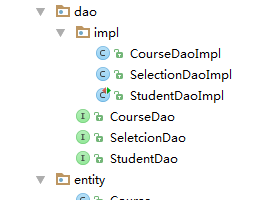
对应代码
public interface CourseDao {
void insert(Course stu);
void update(Course stu);
void delete(int id);
Course select(int id);
List<Course> selectAll();
}
@Repository
public class CourseDaoImpl implements CourseDao {
@Autowired
private JdbcTemplate jdbcTemplate;
public void insert(Course course) {
String sql ="insert into student(name,score) values(?,?)";
jdbcTemplate.update(sql,course.getName(),course.getScore());
}
public void update(Course course) {
String sql="update course set name=?,score where id=?"; jdbcTemplate.update(sql,course.getName(),course.getScore(),course.getId());
}
public void delete(int id) {
String sql="delete from course where id=?";
jdbcTemplate.update(sql,id);
}
public Course select(int id) {
String sql ="select * from course where id=?";
return jdbcTemplate.queryForObject(sql,new CourseRowMapper(),id);
}
public List<Course> selectAll() {
String sql ="select * from course ";
return jdbcTemplate.query(sql,new CourseRowMapper());
}
private class CourseRowMapper implements RowMapper<Course> {
public Course mapRow(ResultSet resultSet, int i) throws SQLException {
Course course=new Course();
course.setId(resultSet.getInt("id"));
course.setName(resultSet.getString("name" ));
course.setScore(resultSet.getInt("score"));
return course;
}
}
}
public interface SeletcionDao {
void insert(List<Selection> seles);
void delete(int sid,int cid);
List<Map<String,Object>> selectByStudent(int sid);
List<Map<String,Object>> selectByCourse(int cid);
}
@Repository
public class SelectionDaoImpl implements SeletcionDao {
@Autowired
private JdbcTemplate jdbcTemplate;
public void insert(List<Selection> seles) {
String sql="insert into selection values(?,?,?,?)";
List<Object[]> list=new ArrayList<Object[]>();
for(Selection selection:seles){
Object[] args=new Object[4];
args[0]=selection.getSid();
args[1]=selection.getCid();
args[2]=selection.getSelTime();
args[3]=selection.getScore();
list.add(args);
}
jdbcTemplate.batchUpdate(sql,list);
}
public void delete(int sid,int cid) {
String sql="delete from selection where student=? and course=?";
jdbcTemplate.update(sql,sid,cid);
}
public List<Map<String, Object>> selectByStudent(int sid) {
String sql="select se.* , stu.name sname ,cou.name cname" +
"from selection se left join student stu on se.student=stu.id " +
"left join course cou onse.course=cou.id"+
"where student=?";
return jdbcTemplate.queryForList(sql,sid);
}
public List<Map<String, Object>> selectByCourse(int cid) {
String sql="select se.* , stu.name sname ,cou.name cname" +
"from selection se left join student stu on se.student=stu.id " +
"left join course cou onse.course=cou.id"+
"where course=?";
return jdbcTemplate.queryForList(sql,cid);
}
}
public interface StudentDao {
void insert(Student stu);
void update(Student stu);
void delete(int id);
Student select(int id);
List<Student> selectAll();
}
@Repository("studentDaoImpl")
public class StudentDaoImpl implements StudentDao {
@Autowired
private JdbcTemplate jdbcTemplate;
public void insert(Student stu) {
String sql ="insert into student(name,sex,born) values(?,?,?)";
jdbcTemplate.update(sql,stu.getName(),stu.getSex(),stu.getBorn());
}
public void update(Student stu) {
String sql="update student set name=?,sex=?, born=? where id=?";
jdbcTemplate.update(sql,stu.getName(),stu.getSex(),stu.getBorn(),stu.getId());
}
public void delete(int id) {
String sql="delete from student where id=?";
jdbcTemplate.update(sql,id);
}
public Student select(int id) {
String sql ="select * from student where id=?";
return jdbcTemplate.queryForObject(sql,new StudentRowMapper(),id);
}
public List<Student> selectAll() {
String sql ="select * from student ";
return jdbcTemplate.query(sql,new StudentRowMapper());
}
private class StudentRowMapper implements RowMapper<Student> {
public Student mapRow(ResultSet resultSet, int i) throws SQLException {
Student stu=new Student();
stu.setId(resultSet.getInt("id"));
stu.setName(resultSet.getString("name" ));
stu.setSex(resultSet.getString("sex"));
stu.setBorn(resultSet.getDate("born"));
return stu;
}
}
}
